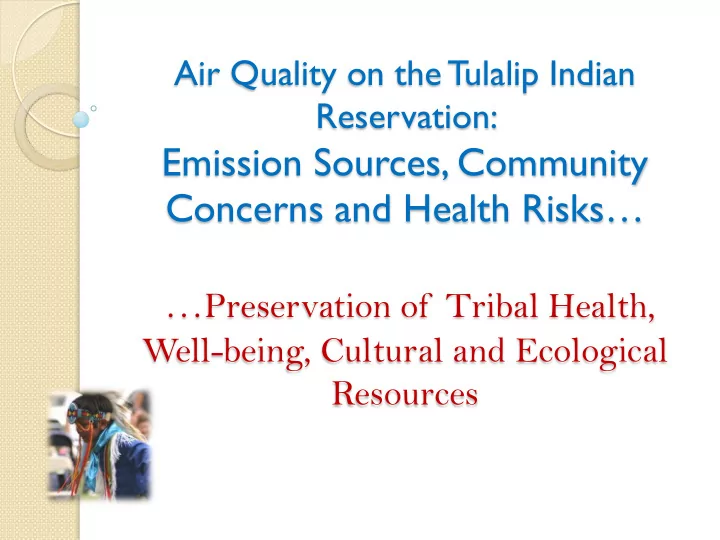

Air Quality on the Tulalip Indian Reservation: Emission Sources, Community Concerns and Health Risks… … Preservation of Tribal Health, Well-being, Cultural and Ecological Resources
TJ…a Tulalip grass dancer with asthma
I. Emission Sources On and Adjacent to the Tulalip Indian Reservation
On-Reservation/Local Emission Sources Outdoor burning ( residential, land-clearing operations, forestry management ) Residential wood combustion ( predominantly woodstoves ) On-road mobile sources ( unpaved gravel roads, 2-lane highways, interstate ) Off-road mobile sources ( marine engines ) Minor sources
Off-Reservation Area Sources Interstate 5 Marine - Port of Everett (deepwater bay on Puget Sound) Rail – Burlington Northern Residential wood combustion (woodstoves and fireplaces) Permitted facilities
2009 Emissions Inventory Marine vessel emissions Woodstove emissions Outdoor burning emissions Stationary facility emissions Mobile emissions
II. Community Concerns
Asthma in native populations ( as in many ethnic groups ) is the product of underlying health, environmental and cultural disparities.
Health Disparities High incidence of RSV (respiratory virus) in AI/AN infants and children, which is recognized as a factor in triggering the onset of asthma later in childhood (1). Certain non-respiratory conditions, such as diabetes and high blood pressure, are statistically higher in AI/AN communities, and are associated with an increased risk of premature stroke or heart attack during episodes of poor air quality (2) .
Allergic Diseases : Eczema, Hay Fever, Chronic Rhinosinusitis Respiratory Diseases : Asthma, Chronic Bronchitis, Emphysema Pulmonary Disease : Hypertension Inflammatory Diseases : Diabetes
III. Emissions and Human Health Implications
• Surface area of lungs is equal to the total surface area of a tennis court • Greater than 100 sq yards • 80 times the surface area of your skin
Blue columns represent the smallest parts of the lungs, called first-generation bronchioles, where fine PM is trapped. The graph illustrates the increase in airway damage at this level, where pollutants cannot be effectively cleared from the airways through normal mucosal or cilliary movement .
RESPIRATORY DISTRESS AND ACUTE HEALTH OUTCOMES DIRECTLY ASSOCIATED WITH AIR QUALITY Tracking data ties increase • in fine PM (short term) to acute health outcomes… artery constriction which leads to cardiovascular events (stroke and heart attack) Fine particles produce • pollutant-induced oxidative stress, which may accelerate remodeling
IV. Mechanisms for Addressing Air Quality at Tulalip
Ambient Air Quality Monitoring (PM 2.5 ) Enforcement of Outdoor Burning Regulations (Tribal Code and Federal Air Rules for Reservations) Targeted Emissions-Reduction Initiatives (Fishing Vessel Repower Project – 2012) Education and Outreach
Recommend
More recommend